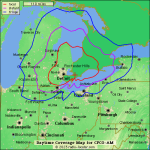Hi everyone,
I'm not from Detroit (and have never had a chance to visit). I have, however, listened to CKWW on and off for many years via their online stream. I'm curious about how well the station actually comes in if you're trying to listen to it anywhere around Detroit. Looking at the daytime and nighttime pattern online, it looks like the pattern isn't exactly favorable to Detroit listeners (but I would assume there are people who still listen).
How well does CKWW get out? At 580 on the AM dial, maybe it still does pretty well.
I'm not from Detroit (and have never had a chance to visit). I have, however, listened to CKWW on and off for many years via their online stream. I'm curious about how well the station actually comes in if you're trying to listen to it anywhere around Detroit. Looking at the daytime and nighttime pattern online, it looks like the pattern isn't exactly favorable to Detroit listeners (but I would assume there are people who still listen).
How well does CKWW get out? At 580 on the AM dial, maybe it still does pretty well.


